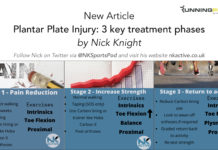Our articles are not designed to replace medical advice. If you have an injury we recommend seeing a qualified health professional. To book an appointment with Tom Goom (AKA ‘The Running Physio’) visit our clinic page. We offer both in-person assessments and online consultations.
We’re joined once again today by top podiatrist Simon Bartold. Regular readers will know Simon has written some cracking articles for us in the past, all of which you can find here. He joins us today to challenge common conceptions around shoe selection for runners. Follow Simon on twitter via @bartoldbiomecha and check out his excellent website – bartoldbiomechanics.com
Motion control, Neutral, Cushion and Structured Cushioning.. the bedrock of running shoe classification for at least 35 years, and one that remains in about 99.9% of retail to this day. And, it really worries me, because.. it is all wrong!

The story goes something like this: if you have a low arched foot type, or are an “overpronator”, you are at increased risk of overuse injury. As a result, the running footwear you choose must be of the Motion Control Category, because this will “control” your “overpronation” and “prevent” you from getting “injured”.
Have you noticed that I am using a lot of “quote icon” that emphasize my scepticism at these comments?!!
Conversely, if you are an “underpronator”, you are at increased risk of injury because there is increased shock transmitted through the system because of increased rigidity, and therefore you must be in a Cushioning category shoe. There are not as many “quotes” in this statement, because there is a fair element of truth to it, however, it is not without its problems.
Finally, if one has “perfect biomechanics” an oxymoron if ever there were one, you must wear a “Neutral” category running shoe.
As a consequence, nearly every running shoe store, technical or otherwise, in the world will have a similar layout with the now-standard classification of ‘Neutral’, ‘Motion Control’ etc.
Now, I hope you have spotted the numerous issues with this hotbed of wicked lies perpetrated by the running shoe industry (and some medical) for more years than I care to remember!
First, who amongst us is brave enough to give a definition of an “overpronator”?
Not me, because I have seen far too many athletes with what would, by most standard definitions, be deemed overpronators, functioning perfectly well, and often at the very highest level. A point in case is the athlete pictured here, who represented Australia at the Olympic Games in Basketball… twice. And NEVER had a musculoskeletal injury!!

I prefer to think of people as operating within an “envelop of function”. For some, this envelop will have very little margin, and for other, like this individual, the envelop will be very large indeed.
Of course, the envelop of function will be influenced by a myriad of other factors, like age, sex, genetics, weight, height, systemic health and physiologic fitness, which all combine to determine outcomes related to function and injury.
The same issues exist with the term “underpronator”, there simply is no line in the sand we can rely upon. That said, I believe the cause and effect of having reduced range of motion is clearer than having increased ROM. For the most part, I would endorse the concept of a more cushioned shoe for the more rigid, underpronating foot.
Just remember though, rules are meant to be broken! If we take the example of our basket balling friend above, I am betting 90% of people would put him in a stability or “Motion Control” shoe. And that would be 100% the wrong choice because he is operating right at the end of his subtalar joint’s pronation range. He has no available pronation from contact to midstance, and as a consequence, he sounds like a herd of baby Rhinoceroses when he walks! This man.. above all others, needs Cushioning category footwear because he has lost the normal contact phase shock and impact attenuating mechanisms.
But let’s get back to the attention-grabbing title of this little diatribe… why do we bother with “segmentation” or if you like the categorization of footwear at all?
The Runner’s World Shoe Testing Laboratory, headed by that biomechanical doyen Dr. Martyn Shorten, has just completely abandoned all terminology relating to running footwear segmentation in its test reporting. No more Neutral.. no more Cushioning… no more BLOODY Motion Control!! Yippee, and this is where I gratuitously congratulate myself for going on record in July of 1999, saying I believed the term Motion Control should be abandoned.. forever.
I know I cannot get away with a mere opinion here, so let’s see if I can back this up with something a little more scientific, but first… the practicalities.
Number one, it is not possible to “control” motion.. not with a shoe or an orthosis at least. It certainly is possible to create influences, but in the context of the Motion Control discussion of the last 35 years, this is a fallacy. A highly pronating foot will continue to pronate happily inside the most heavily “Motion Controlling” shoe until the cows come home.. and.. the result of the interaction between foot and footwear is heavily case specific. The main effect observed in one person will not be identical to that observed in the next. And yet, we have been told Motion Control footwear is what all “pronators” need. To me, this is as much a nonsense as saying all runners must wear minimalist footwear or run barefoot. It is counter-intuitive, contrary to the science, and…. Likely to contribute to injury for at least some runners!
Number two, it is not possible to build a motion control shoe without a very substantial weight penalty. Weight is the enemy of all runners.. end of story.
Number three, responsiveness is important, and motion control footwear by default lacks responsiveness and feedback. This is never a good situation.
Ok… now to the science.. in 2010, a highly respected team of scientists published a paper (Knapik et al) based heavily on 6 years of previous research, that established it was not possible to accurately match a shoe to a foot, based on arch profile. Furthermore, they were able to demonstrate that when a low arched (or “pronated”) foot was matched to a motion control shoe, per the manufacturer’s recommendations, there was zero positive outcomes in relation to overuse running injury.
So.. the question must be asked:
“if you cannot match foot type to shoe category, and if this has no impact on injury outcomes, why categorise?”
Now, this was a proper bit of research, a randomised control trial, with a level of evidence 1, with 722 subjects in the experimental cohort and 789 in the control group, and the group followed this up with an even larger study published in 2014, which concluded
“there was little difference in injury rates between military recruits who wore a running shoe assigned on the basis of plantar-shape foot arch height compared to those who were assigned a stability shoe regardless of plantar shape.”
The smoking gun, however, was really revealed in 2011 when long time Nike Biomechanist, Gordon Valiant and co-workers published a paper examining the injury status in women runners who were randomised to receive a neutral, stability or motion control running shoe.
Predictably, they found:
“our current approach of prescribing in-shoe pronation control systems on the basis of foot type is overly simplistic and potentially injurious.”
So at best, stratification of running shoes is nonsensical, at worse, dangerous.
The other issue is that the concept of buying a shoe based on the current categories consigns the buyer to a place with no room to move. And just like Macbeth, this room is likely to be full of sound and fury.. signifying.. nothing! It is a square box as below, with the consumer trapped in the middle of confusion, the kid on the floor rushing toward motion control, neutral or cushioning section of the store, without really understanding the implications.

It is time for a different approach, a simpler but more meaningful approach that takes outdated and inaccurate habits out of the picture.
How to do it? Well, that is open for discussion, but recent research suggests we pick the shoe based on comfort. This fairly simple approach allows for individual variations in foot shape and movement. Like many things, it’s far from set in stone though and emerging studies may challenge this method. It seems it may take time for science to find a way that truly fits for all.
For more from Simon check out the awesome bartoldbiomechanics.com



![Stress fractures of the foot & ankle [infographic]](https://www.running-physio.com/wp-content/uploads/2014/07/Stress-Fractures-Foot-Ankle-2024-100x70.png)




